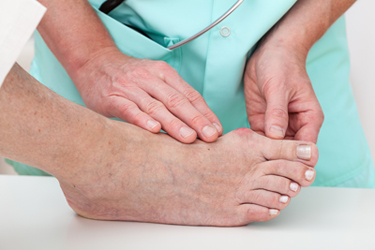NJ (908) 688-5577
NY (212) 737-2528
 An abnormality in which a bony bump forms on the big toe of your foot can be referred to as a bunion. The bone in your big toe is typically deformed and generally causes pain and discomfort. Choosing shoes with enough room in the toe area may prevent bunions from worsening, allowing the toes to feel less restricted. Wide shoes with a low heel are often recommended. Ways to ease the pain a bunion produces can include putting ice on it for a few minutes and placing a soft pad in your shoe. This can help decrease or completely remove friction that frequently occurs as the bunion rubs against the shoe. If daily activities are being affected by the pain a bunion causes, see a podiatrist for treatment.
An abnormality in which a bony bump forms on the big toe of your foot can be referred to as a bunion. The bone in your big toe is typically deformed and generally causes pain and discomfort. Choosing shoes with enough room in the toe area may prevent bunions from worsening, allowing the toes to feel less restricted. Wide shoes with a low heel are often recommended. Ways to ease the pain a bunion produces can include putting ice on it for a few minutes and placing a soft pad in your shoe. This can help decrease or completely remove friction that frequently occurs as the bunion rubs against the shoe. If daily activities are being affected by the pain a bunion causes, see a podiatrist for treatment.
If you are suffering from bunions, contact Glenn Davison, DPM of Advanced Podiatry. Our doctor can provide the care you need to keep you pain-free and on your feet.
What Is a Bunion?
A bunion is formed of swollen tissue or an enlargement of boney growth, usually located at the base joint of the toe that connects to the foot. The swelling occurs due to the bones in the big toe shifting inward, which impacts the other toes of the foot. This causes the area around the base of the big toe to become inflamed and painful.
Why Do Bunions Form?
Genetics – Susceptibility to bunions are often hereditary
Stress on the feet – Poorly fitted and uncomfortable footwear that places stress on feet, such as heels, can worsen existing bunions
How Are Bunions Diagnosed?
Doctors often perform two tests – blood tests and x-rays – when trying to diagnose bunions, especially in the early stages of development. Blood tests help determine if the foot pain is being caused by something else, such as arthritis, while x-rays provide a clear picture of your bone structure to your doctor.
How Are Bunions Treated?
If you have any questions, please feel free to contact our offices located in Union, NJ and New York . We offer the newest diagnostic and treatment technologies for all your foot care needs.